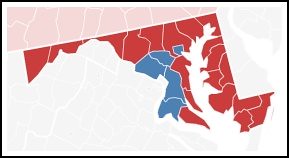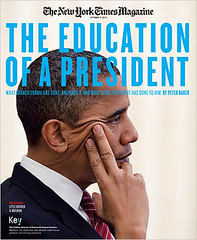Urban archipelago revisited
After the 2004 National Election, the editors of The Stranger, the alternative weekly published in Seattle, wrote a screed about the urban vs. suburban/rural political divide. See "The Urban Archipelago: It's the Cities, Stupid."


Election results by district, House of Representatives, Washington Post graphic
Then again, while Gov. O'Malley whupped Bob Ehrlich pretty decisively in the Governor's race in Maryland,even there, most of the state went for Ehrlich in terms of land mass, while O'Malley garnered tremendous numbers of votes in Prince George's and Montgomery Counties and Baltimore City, a decent enough win in Howard and Charles Counties, and was even in Baltimore County (a win in a way, since Ehrlich is from Baltimore County and rolled up big numbers there in 2002), while he was outpolled in every other jurisdiction (although not too far off in Anne Arundel and Frederick Counties).

2010 Election results by county, Maryland Governor, Washington Post graphic. (Blue denotes a majority of Democratic voters, Red a majority of Republican voters.)
It would be interesting to map both of these results by level of educational attainment. Today's Post includes a column by Harold Meyerson, "A post-election numbers game," that does provide some demographic information and statistics regarding voting in Tuesday's election. Younger people voted Democrat. Less educated people voted Republican--unless they were members of Unions, and had access to union organizing campaigns and information.
Labels: civic engagement, elections and campaigns, electoral politics and influence, Growth Machine, participatory democracy and empowered participation, urban vs. suburban vs. rural




0 Comments:
Post a Comment
<< Home